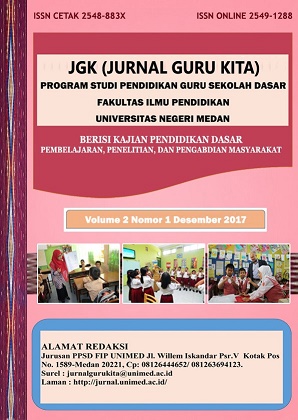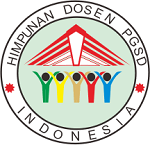PENERAPAN MODEL SQ3R DALAM PEMBELAJARAN BAHASA INDONESIA UNTUK MENINGKATKAN KETERAMPILAN MEMBACA KELAS IV SDN 167 SIBANGGOR JAE
DOI:
https://doi.org/10.24114/jgk.v2i1.10448Abstract
Abstrak: Penerapan Model SQ3R dalam Pembelajaran Bahasa Indonesiauntuk Meningkatkan Keterampilan Membaca Kelas IV SDN 167 SibanggorJae. Penelitian ini adalah penelitian tindakan kelas dengan dua siklus. Subjek dalampenelitian adalah seluruh siswa kelas V SDN 167 Sibanggor Jae, yang berjumlah 20siswa. Dalam penelitian ini, aktivitas belajar siswa diperoleh melalui observasidalam Kegiatan Belajar Mengajar (KBM). Hasil belajar berupa keterampilanmembaca pemahaman siswa meningkat dengan menerapkan strategi pembelajaranSQ3R pada Formatif I menunjukkan rata-rata 72 dengan ketuntasan kalsikal 60%dan pada Formatif II menunjukkan rata-rata 89 dengan ketuntasan klasikal 95%atau terjadi peningkatan 35%, data tersebut menunjukkan peningkatan dan tuntassesuai dengan Kriteria Ketuntasan Minimal (KKM) bahasa Indonesia.Downloads
Published
2018-08-11
How to Cite
Hanum, L. (2018). PENERAPAN MODEL SQ3R DALAM PEMBELAJARAN BAHASA INDONESIA UNTUK MENINGKATKAN KETERAMPILAN MEMBACA KELAS IV SDN 167 SIBANGGOR JAE. JGK (Jurnal Guru Kita), 2(1), 10–19. https://doi.org/10.24114/jgk.v2i1.10448
Issue
Section
Articles
License
Authors published with the JGK (Jurnal Guru Kita) agree to the following terms:
- Authors retain copyright and grant the journal the right of first publication with the work simultaneously licensed under a Creative Commons Attribution License (CC BY-SA 4.0) that allows others to share the work with an acknowledgment of the work's authorship and initial publication in this journal.
- Authors are able to enter into separate, additional contractual arrangements for the non-exclusive distribution of the journal's published version of the work (e.g., post it to an institutional repository or publish it in a book), with an acknowledgment of its initial publication in this journal.
- Authors are permitted and encouraged to post their work online (e.g., in institutional repositories or on their website) prior to and during the submission process, as it can lead to productive exchanges, as well as earlier and greater citation of published work. (See The Effect of Open Access)


























